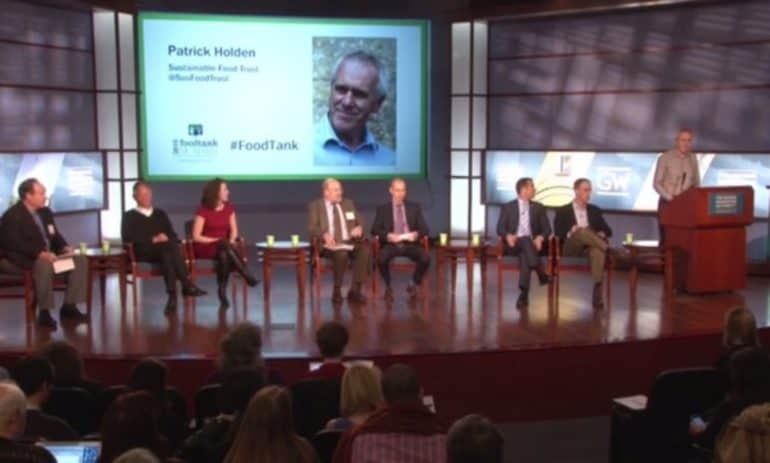The panel, “True Cost Accounting in the Food System,” highlighted a major theme from the Food Tank Summit: cheap food is expensive. Each speaker gave their perspective on either a serious cost burden created by the proliferation of cheap food, or a potential solution to the growing negative externalities.
Keynote speaker Patrick Holden of the Sustainable Food Trust began the panel by discussing some of the issues leading to the true cost of food. Holden noted that the business case for farming often leads to unsustainable practices. If polluters are not penalized for their actions, they will use the most intensive practices because those practices result in higher yields and profits. To capture the true cost of food, Holden called for the need “to quantify [the externalities] so we can put a price on the damage caused.” His multi-pronged solutions include taxation, regulation, legislation, redirection of subsidies, and pricing changes.
The panel discussion began with Pete Myers of Environmental Health Sciences. Myers focused on the cost of negative health effects from the chemicals used in farming. He stated that the use of pesticides results in US$10 billion worth of health costs. Unfortunately, Myers claims that the U.S. Environmental Protection Agency (EPA) and the U.S. Food and Drug Administration (FDA) are not adequately prepared to deal with these issues because, as he says, “the tools they use are decades out of date. They are so far out of date that we can’t count on them.”
Jenn Yates of the Union of Concerned Scientists focused on the additional cost the food system carries through federal subsidies. She lamented the current system: “It’s not an accident that we grow so much corn and soybean commodity crops. It’s not an accident that we only use 2 percent of land for fruits and vegetables.” She noted that this often results in “billions in subsidies, billions to deal with externalities.”
David Aylward of Ashoka emphasized the need for better consumer tools to understand their food. Aylward noted that while new innovations were still on the horizon, his recommendation is to “empower people with tools that measure nourishment.” He also acknowledged the importance of measuring positive food externalities, such as enhanced vitality, children’s ability to learn, and fuel for working.
Tom McDougall of 4P Foods discussed an alternative business model to address some of the underlying food externalities. He emphasized that “we can use the engine of business to do something about the true cost of food.” By rethinking the definition of profitability, McDougall stressed that the private sector could provide societal benefits while growing their businesses.
Paul Shapiro of the Humane Society of the United States discussed animal cruelty as a food production externality. He described the abhorrent animal conditions that are often caused by the continuous drive for higher profits. Shapiro also celebrated the Humane Society’s successes, but cautioned that individual consumers aren’t enough to drive change. He noted that work with corporations often results in a larger-scale change that sets industry standards. Shapiro says that the key is that “we’re not asking to implement an idyllic food system, just asking to improve their current system.”
Finally, John Buchanan from Conservation International emphasized corporate partnerships as a potential lever for sustainable agriculture. His solution was to start with large-scale buyers, such as Walmart and Unilever, to change their supply policies and practices so that farmers are incentivized to adopt these new methods. However, he noted that “tremendous progress in the private sector is due to consumer pressure.”
Written by Natalie Talis, GW Student













